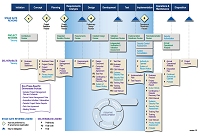Enterprise Performance Life Cycle (EPLC)
HHS Enterprise Performance Life Cycle - The Department of Health and Human Services [HHS] Enterprise Performance Life Cycle [EPLC] is a framework to enhance Information Technology [IT] governance through rigorous application of sound investment and project management principles and industry’s best practices. The HHS EPLC provides the context for the HHS IT governance process and describes interdependencies between its project management, investment management, and capital planning components.
EPLC Framework

IHS EPLC Master Diagram [PDF - 1.31 MB]
IHS Standard Operating Procedure for EPLC Framework [PDF - 699 KB] - This document is to establish an Enterprise Performance Life Cycle (EPLC) policy for the Indian Health Service (IHS), which adheres to the United States Department of Health and Human Services (HHS) EPLC Framework. The document identifies how IHS will incorporate the EPLC phases and deliverables into the Capital Planning and Investment Control (CPIC) process, defines the required fundamentals, and outlines a strategy for tailoring projects within the IHS.
CPIC Business Needs Statement & Business Case Application
Business Need Statement
A Business Need Statement (BNS) identifies a business need that can be met by an IT solution. The BNS provides sufficient information to determine whether the proposed work should be treated as part of Operations and Maintenance (O&M) for an existing deployed system or business function; or whether the project represents Development Modernization and Enhancement (DME) work that must conform to the documentation and process requirements of the Enterprise Performance Life Cycle (EPLC). The Business Need Statement is the form utilized to provide this information to the authorizing IT Governance body. The development and approval of the BNS is considered the Initiation Phase of the EPLC.
The BNS originates from the IT Project Sponsor (typically the business owner of the Federal business Division, Area, or Office) or designee, and is submitted to the Investment Manager for review and approval for incorporation into one of the three IHS major IT investments. If approved, the BNS will undergo further review and approval by the IHS Enterprise Architect (EA) and the Chief Information Officer (CIO) for authorization. The CIO approval will constitute authority to develop a full Business Case and additional artifacts required by the EPLC framework best practices.
Business Case
The IHS IT Business Case summarizes the justification for development of an IT project to meet an identified business need and how that business need meets the Mission and Priorities of IHS. A Business Case is a documented, structured proposal for business improvement that facilitates a selection decision for a project by the IHS IT governance organizations. The Business Case describes the reasons and justification for the project in terms of business process performance needs and/or problems, and expected benefits. An effective Business Case will have identified the solutions, assumptions, constraints, a risk-adjusted cost benefit analysis, and a preliminary acquisition plan. The Business Case provides information on the analysis of alternatives completed to ensure the appropriate IT solution is selected.
The IHS IT Business Case requires the approval of the CIO for moderate projects with a 5-year lifecycle estimated cost of $500K or less. Projects with a five-year lifecycle greater than $500K will be reviewed by the IHS IT investment review board (ITIRB) for approval. Approval of the Business Case authorized successful completion of the Concept Stage Gate Review of the IHS EPLC, and permission to develop project management documents and the project baseline in the planning phase.


